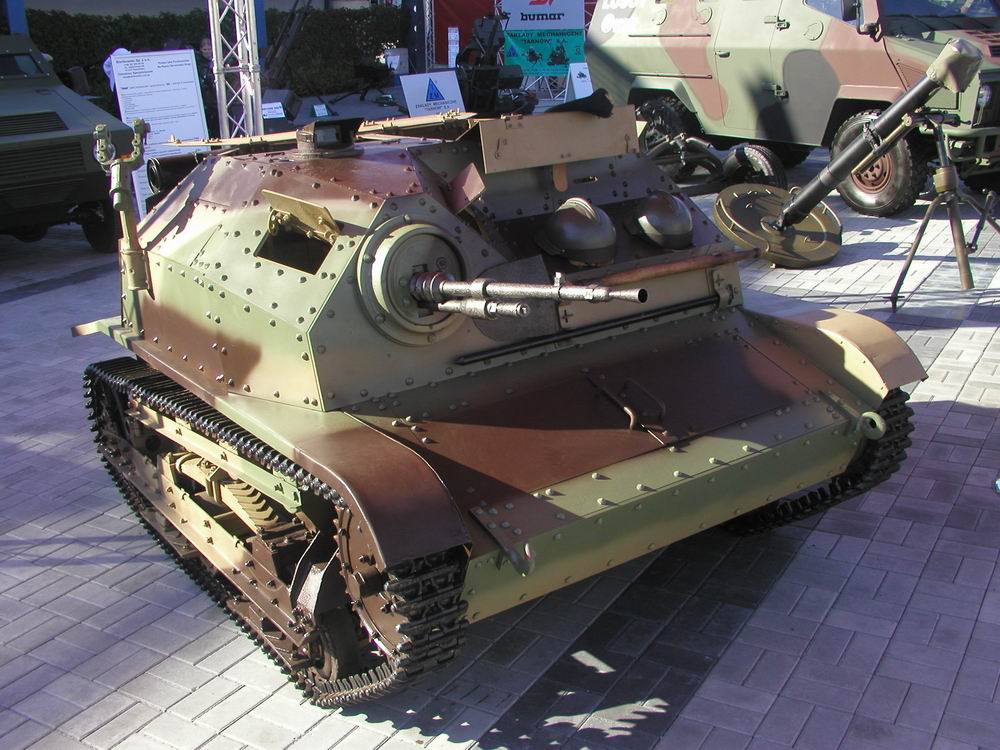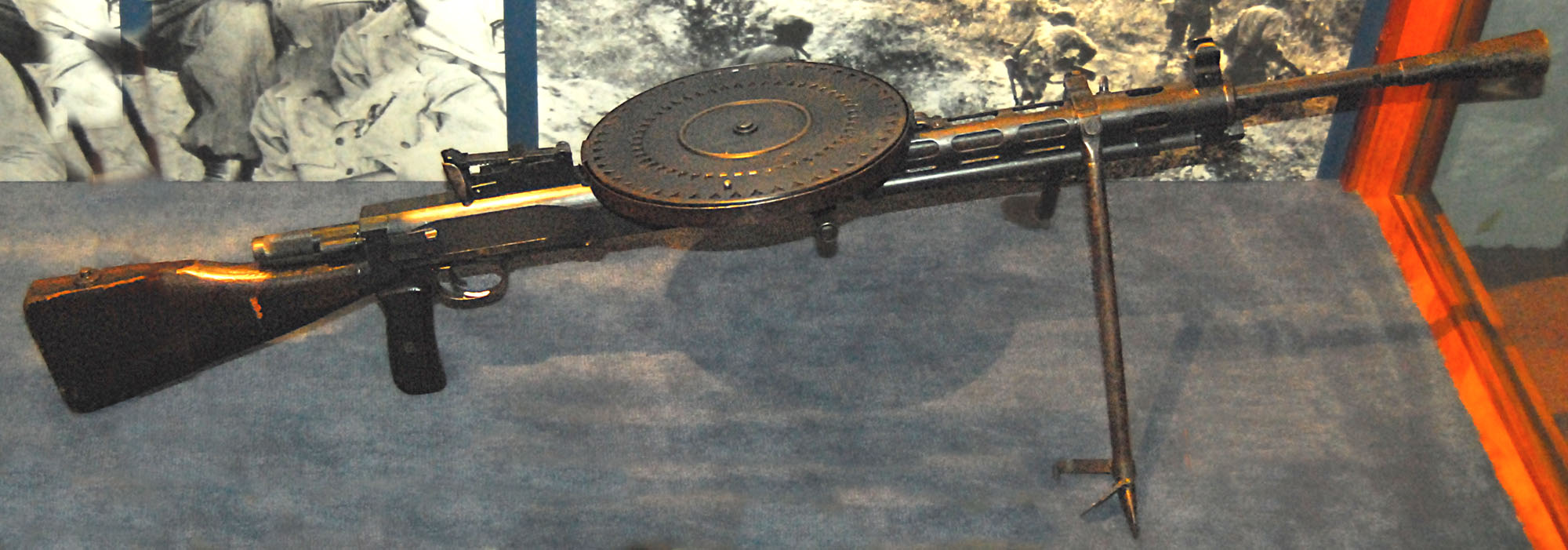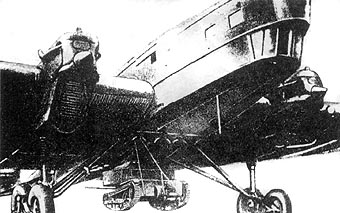|
T-23 Tankette
The T-23 was a prototype tankette developed by the Soviet Union during the interwar period. Only 5 Examples of the vehicle were produced. Design history The development of the T-23 began in 1929. The Red Army, now with experience from the earlier T-17 tankette, began development of the T-23. The design featured 2 crew members (placed on a row) with a single 7.62 mm DT machine gun as the primary armament. The armour was made of riveted iron and was up to 10 mm thick on the front and sides of the vehicle. It was equipped as well with a tail, similar to that of the T-18 tank. Many of the original design features of the tank were changed during the development. Originally the T-23 was to contain the same 35 hp 4 cylinder engine as the T-18 light tank but this was eventually changed to a larger 60 hp version to enable it to reach speeds of up to 40 km/h. The length of the tank was also increased by almost 30 cm from original specifications. Production ... [...More Info...] [...Related Items...] OR: [Wikipedia] [Google] [Baidu] |
Tankette
A tankette is a tracked armoured fighting vehicle that resembles a small tank, roughly the size of a car. It is mainly intended for light infantry support and scouting.T-27 Tankette (from the 'battlefield.ru' website, with further references cited. Accessed 2008-02-21.) Colloquially it may also simply mean a small tank. Several countries built tankettes between the 1920s and 1940s, and some saw limited combat in the early phases of . The vulnerability of their light armour, however, eventually led armies to abandon the concept with some exceptions such as the more modern German Wiesel (Weasel) series. ...
|
DT Machine Gun
The Degtyaryov machine gun (russian: Пулемёт Дегтярёвa Пехотный, Pulemyot Degtyaryova Pekhotny literally: "Degtyaryov's infantry machine gun") or DP-27/DP-28 is a light machine gun firing the 7.62×54mmR cartridge that was primarily used by the Soviet Union, with service trials starting in 1927, followed by general deployment in 1928. Besides being the standard Soviet infantry light machine gun (LMG) during World War II, with various modifications it was used in aircraft as a flexible defensive weapon, and it equipped almost all Soviet tanks in WWII as either a flexible bow machine gun or a co-axial machine gun controlled by the gunner. It was improved in 1943 producing the DPM, but it was replaced in 1946 with the RP-46 which improved on the basic DP design by converting it to use belt feed. The DP machine gun was supplemented in the 1950s by the more modern RPD machine gun and entirely replaced in Soviet service by the general purpose PK machine gun in t ... [...More Info...] [...Related Items...] OR: [Wikipedia] [Google] [Baidu] |
Tankette
A tankette is a tracked armoured fighting vehicle that resembles a small tank, roughly the size of a car. It is mainly intended for light infantry support and scouting.T-27 Tankette (from the 'battlefield.ru' website, with further references cited. Accessed 2008-02-21.) Colloquially it may also simply mean a small tank. Several countries built tankettes between the 1920s and 1940s, and some saw limited combat in the early phases of . The vulnerability of their light armour, however, eventually led armies to abandon the concept with some exceptions such as the more modern German Wiesel (Weasel) series. ...
|
Soviet Union
The Soviet Union,. officially the Union of Soviet Socialist Republics. (USSR),. was a transcontinental country that spanned much of Eurasia from 1922 to 1991. A flagship communist state, it was nominally a federal union of fifteen national republics; in practice, both its government and its economy were highly centralized until its final years. It was a one-party state governed by the Communist Party of the Soviet Union, with the city of Moscow serving as its capital as well as that of its largest and most populous republic: the Russian SFSR. Other major cities included Leningrad (Russian SFSR), Kiev (Ukrainian SSR), Minsk ( Byelorussian SSR), Tashkent (Uzbek SSR), Alma-Ata (Kazakh SSR), and Novosibirsk (Russian SFSR). It was the largest country in the world, covering over and spanning eleven time zones. The country's roots lay in the October Revolution of 1917, when the Bolsheviks, under the leadership of Vladimir Lenin, overthrew the Russian Provisional Government ... [...More Info...] [...Related Items...] OR: [Wikipedia] [Google] [Baidu] |
Interwar Period
In the history of the 20th century, the interwar period lasted from 11 November 1918 to 1 September 1939 (20 years, 9 months, 21 days), the end of the World War I, First World War to the beginning of the World War II, Second World War. The interwar period was relatively short, yet featured many significant social, political, and economic changes throughout the world. Petroleum-based energy production and associated mechanisation led to the prosperous Roaring Twenties, a time of both social mobility and economic mobility for the middle class. Automobiles, electric lighting, radio, and more became common among populations in the developed world. The indulgences of the era subsequently were followed by the Great Depression, an unprecedented worldwide economic downturn that severely damaged many of the world's largest economies. Politically, the era coincided with the rise of communism, starting in Russia with the October Revolution and Russian Civil War, at the end of World War I ... [...More Info...] [...Related Items...] OR: [Wikipedia] [Google] [Baidu] |
T23 Tankette 01
T, or t, is the twentieth letter in the Latin alphabet, used in the modern English alphabet, the alphabets of other western European languages and others worldwide. Its name in English is ''tee'' (pronounced ), plural ''tees''. It is derived from the Semitic Taw 𐤕 of the Phoenician and Paleo-Hebrew script (Aramaic and Hebrew Taw ת/𐡕/, Syriac Taw ܬ, and Arabic ت Tāʼ) via the Greek letter τ (tau). In English, it is most commonly used to represent the voiceless alveolar plosive, a sound it also denotes in the International Phonetic Alphabet. It is the most commonly used consonant and the second most commonly used letter in English-language texts. History '' Taw'' was the last letter of the Western Semitic and Hebrew alphabets. The sound value of Semitic ''Taw'', Greek alphabet Tαυ (''Tau''), Old Italic and Latin T has remained fairly constant, representing in each of these; and it has also kept its original basic shape in most of these alphabets. Use in ... [...More Info...] [...Related Items...] OR: [Wikipedia] [Google] [Baidu] |
Gun Turret
A gun turret (or simply turret) is a mounting platform from which weapons can be fired that affords protection, visibility and ability to turn and aim. A modern gun turret is generally a rotatable weapon mount that houses the crew or mechanism of a projectile-firing weapon and at the same time lets the weapon be aimed and fired in some degree of azimuth and elevation (cone of fire). Description Rotating gun turrets protect the weapon and its crew as they rotate. When this meaning of the word "turret" started being used at the beginning of the 1860s, turrets were normally cylindrical. Barbettes were an alternative to turrets; with a barbette the protection was fixed, and the weapon and crew were on a rotating platform inside the barbette. In the 1890s, armoured hoods (also known as "gun houses") were added to barbettes; these rotated with the platform (hence the term "hooded barbette"). By the early 20th Century, these hoods were known as turrets. Modern warships have gu ... [...More Info...] [...Related Items...] OR: [Wikipedia] [Google] [Baidu] |
Carden Loyd Tankette
The Carden Loyd tankettes were a series of British tankettes of the period between the World Wars, the most successful of which was the Mark VI, the only version built in significant numbers. It became a classic tankette design worldwide, was licence-built by several countries and became the basis of several designs produced in various countries. Development The Carden Loyd tankette came about from an idea started, as a private project, by the British military engineer and tank strategist Major Giffard LeQuesne Martel. He built a one-man tank in his garage from various parts and showed it to the War Office in the mid-1920s. With the publication of the idea, other companies produced their own interpretations of the idea. One of these was ''Carden-Loyd Tractors Ltd'', a firm founded by Sir John Carden and Vivian Loyd and later purchased by Vickers-Armstrongs. Besides one-man vehicles they also proposed two-man vehicles which turned out to be a more effective and popular idea. Vic ... [...More Info...] [...Related Items...] OR: [Wikipedia] [Google] [Baidu] |
United Kingdom
The United Kingdom of Great Britain and Northern Ireland, commonly known as the United Kingdom (UK) or Britain, is a country in Europe, off the north-western coast of the continental mainland. It comprises England, Scotland, Wales and Northern Ireland. The United Kingdom includes the island of Great Britain, the north-eastern part of the island of Ireland, and many smaller islands within the British Isles. Northern Ireland shares a land border with the Republic of Ireland; otherwise, the United Kingdom is surrounded by the Atlantic Ocean, the North Sea, the English Channel, the Celtic Sea and the Irish Sea. The total area of the United Kingdom is , with an estimated 2020 population of more than 67 million people. The United Kingdom has evolved from a series of annexations, unions and separations of constituent countries over several hundred years. The Treaty of Union between the Kingdom of England (which included Wales, annexed in 1542) and the Kingdom of Scotland in 170 ... [...More Info...] [...Related Items...] OR: [Wikipedia] [Google] [Baidu] |
T-27
The T-27 was a tankette produced in the 1930s by the Soviet Union. It was based on the design of the Carden Loyd tankette, bought under license from the United Kingdom in 1930. Design The Soviets were not fully satisfied with the Carden Loyd design and made a number of changes before putting it into mass production under the designation of T-27. Compared with the British original, the hull was larger, the running gear was improved and the weapon mount was modified to take a Soviet 7.62 mm DT machine gun. A number of other changes were made by Chief Engineer N. Kozyrev and Lead Engineer K. Sirken to improve the tankette's ability to cope with the Russian climate and terrain. It lacked any communication devices, as communication between vehicles was intended to be carried out using signal flags. Service The tankette was accepted into service on February 13, 1931. It was manufactured in two factories simultaneously, the Bolshevik factory in Leningrad and what would later become ... [...More Info...] [...Related Items...] OR: [Wikipedia] [Google] [Baidu] |
Tankettes
A tankette is a tracked armoured fighting vehicle that resembles a small tank, roughly the size of a car. It is mainly intended for light infantry support and scouting.T-27 Tankette (from the 'battlefield.ru' website, with further references cited. Accessed 2008-02-21.) Colloquially it may also simply mean a small tank. Several countries built tankettes between the 1920s and 1940s, and some saw limited combat in the early phases of . The vulnerability of their light armour, however, eventually led armies to abandon the concept with some exceptions such as the more modern German Wiesel (Weasel) series. ...
|
Tankettes Of The Interwar Period
A tankette is a tracked armoured fighting vehicle that resembles a small tank, roughly the size of a car. It is mainly intended for light infantry support and scouting.T-27 Tankette (from the 'battlefield.ru' website, with further references cited. Accessed 2008-02-21.) Colloquially it may also simply mean a small tank. Several countries built tankettes between the 1920s and 1940s, and some saw limited combat in the early phases of . The vulnerability of their light armour, however, eventually led armies to abandon the concept with some exceptions such as the more modern German Wiesel (Weasel) series. ...
|







.jpg)